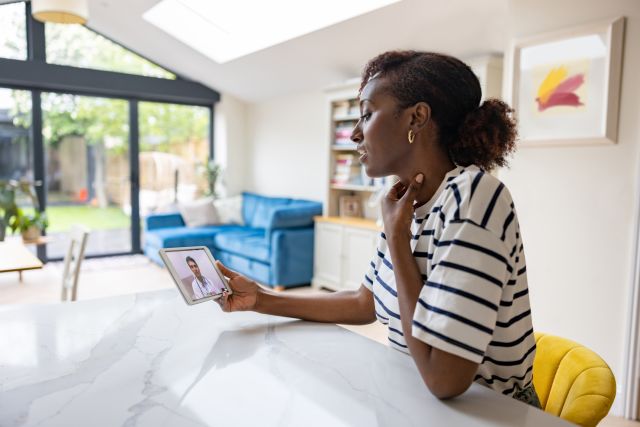Updated on October 20, 2023.
There are a variety of reasons why people don’t seek the medical care they need. Many people in the United States lack ready access to healthcare providers (HCPs). Others without health insurance (or even with health insurance), find the cost of HCP visits too steep. Others may find that their nagging health concern is on the border between needing attention and something they think may resolve on its own.
If any of these categories apply to you, there’s a remedy that may make it easier to find and get the care you need: telemedicine.
The fact is, putting off an appointment with an HCP could put your health at risk. This is particularly true if you have a chronic condition that should be actively managed, like diabetes or high blood pressure.
The good news is that most people with an internet connection and a smartphone, tablet, or computer can “see” an HCP virtually for medical advice and keep follow-up visits without leaving their home.
Telemedicine, also called telehealth, isn’t new. It’s been around for years. But the COVID-19 pandemic transformed this underutilized approach to medicine into a vital resource for patients and HCPs.
During the pandemic, the use of telemedicine increased dramatically. It helped support social distancing by allowing people to receive care without leaving the safety of their home, says James R. Powell, MD, chief medical officer of Long Island Select Healthcare in Suffolk County, New York.
Even though telemedicine rates have subsided since the initial surge of use during the pandemic, the method has solidified its place as a valuable way to increase healthcare access for many Americans. Here’s what to know about telemedicine, and how to make the most of your next telemedicine appointment.
What healthcare providers can do virtually
Online HCP visits are good options when in-person visits are unavailable, hard to access, or overly risky. But how much can an HCP really do virtually? A lot, actually.
Telemedicine can be used to provide almost any type of service that doesn’t require the HCP to touch or smell the patient, says Dr. Powell.
“I know if I can put eyes and ears on someone, I can address 60 to 70 percent of what the patient presents with,” he says. For example, Dr. Powell has used telehealth to treat patients for scabies, diagnose shingles and pneumonia, and assess people after falls.
Limitations to the technology
There are, however, some limitations to recognize. Telemedicine is not a complete substitute for in-person visits, nor are telemedicine visits feasible for all patients or clinical situations.
Any physical exam is naturally going to be limited by the lack of hands-on touch. And while some prescriptions can be made via telemedicine, dosing of weight-based drugs (such as those for chemotherapy or for children) may be difficult due to the inability to accurately weigh patients.
Access and bandwidth can also be an issue. Many people in the U.S. still lack reliable access to high-speed internet. Even among those who do have access, glitches can interfere with a smooth consultation.
In many cases, if any concerning findings arise during a telemedicine visit, an in-person visit at a clinic or emergency room may be necessary. Recurring health issues would also call for a follow-up visit in person. For example, a recurrent urinary tract infection might turn out to be a sexually transmitted infection needing aggressive treatment. A skin rash that doesn’t go away or changes may need to be biopsied to rule out cancer.
It should go without saying that anything that would normally prompt you to head to the emergency room also shouldn’t be treated virtually. This includes seeking advice for potentially life-threatening symptoms, such as chest pain, active bleeding, and anaphylactic shock, notes Tania Elliott, MD, clinical instructor in the department of medicine at New York University Grossman School of Medicine and Langone Health and chief medical officer at Nectar Life Sciences.
Preparing for your virtual visit
The first step in setting up a virtual medical appointment is to download the correct app. It's important to use the same app that your HCP uses, says David Stukus, MD, a professor of clinical pediatrics in the division of allergy and immunology at Nationwide Children’s Hospital in Columbus, Ohio.
After you download the app, fill out all the information requested by your HCP before the visit. “We still need the same information regarding insurance and any forms normally filled out while sitting in the waiting room,” Dr. Stukus says.
Concerned about your Wi-Fi connection? If you can stream movies, you should have enough bandwidth to get through a telemedicine visit, Stukus notes. If your connection is too weak, a phone consultation can be arranged.
The next steps in preparing for your online appointment aren’t much different from how you’d get ready for an in-person visit.
Start by making a list of your symptoms and how long you’ve had them, Dr. Elliott advises. She also recommends doing the following:
- If you think you have a fever, take your temperature with a home thermometer.
- If you have a chronic condition and have a blood pressure cuff, scale, or glucose monitor, take readings right before your visit and write them down. Or take a picture of them on your phone so you can show your HCP.
- If you have a rash, take a photo of it in high resolution or portrait mode.
- If you think you may have a urinary tract infection, buy over-the-counter test strips at your local pharmacy and test your urine before your online appointment.
It’s also important to have a list of your current medications and the doses you are taking, Stukus says. Make sure you know the phone number and address of your local pharmacy if you need refills or a new prescription.
How to schedule and attend your appointment
Telehealth visits can be scheduled by calling your HCP’s office and requesting a virtual visit. Some HCPs also enable patients to schedule telehealth appointments online.
Before your online appointment, your HCP’s office will tell you how to connect with the provider. Typically, you’ll receive a link that you will click on to be connected, Elliott says.
If you would like an HCP consultation right away, there are companies that provide on-demand appointments. There are dozens of apps that are currently in use for telemedicine, including MDLIVE, Lemonaid, LiveHealth, Amwell, and Doctor On Demand.
Think of them as virtual walk-in clinics, says Elliott.
A few minutes before your appointment, take these steps:
- Find a safe, stable place to do your session. (If you’re in your car, pull over and park.)
- Choose a well-lighted, private room. Since you will be speaking about and sharing your personal health information, privacy is important. Try to avoid conducting a telemedicine session in a public place.
- Turn off any television or music noise in the background.
- Make sure your camera and microphone are turned on.
- Use headphones if you have them.
What to expect during a virtual visit
Once you see the HCP appear on the screen, the appointment begins. Your HCP will be able to see and hear you as well. Just like a typical office visit, you’ll be asked about your symptoms and medical history.
Your HCP may walk you through a few steps to perform a physical exam. For example, you may be asked to tap on your sinuses or open your mouth in front of the camera on your device to reveal the back of your throat, Elliott says.
What happens during your visit also depends on why you made the appointment. A visit for a sore throat may last about 10 minutes while a visit for a more complex issue could take longer, she adds.
Telemedicine can be a lifeline for people with disabilities or those who have trouble getting to an in-person appointment. When it works well, telemedicine combines access to care, quality, and convenience, says Joseph C. Kvedar, MD, professor of dermatology at Harvard Medical School and past chair of the board of the American Telemedicine Association. “When these three things come together, it’s a magical outcome.”







